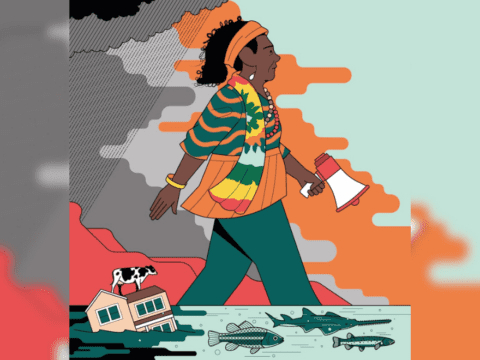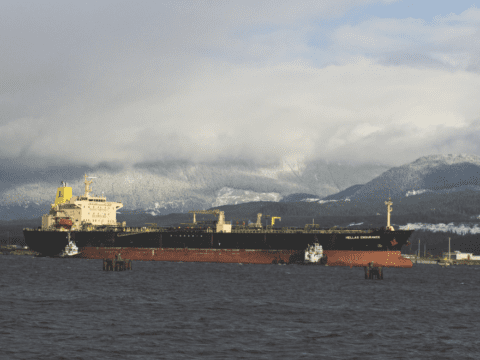“We are now at our last frontier,” wrote Justice Thomas Berger in 1977. “Profound issues, touching our deepest concerns as a nation, await us there.” That frontier was Canada’s great Arctic river, the Mackenzie, and the matter at hand was a proposed 48-inch-diameter, 1,220-kilometre pipeline that would run the length of the river. As the Mackenzie River — Canada’s longest — flowed north through the Northwest Territories to the Beau- fort Sea, trillions of cubic feet of natural gas would flow south, alongside the river but in the opposite direction — water and gas passing silently in the ancient valley. At stake was what Berger, who headed the federally commissioned inquiry into the Mackenzie Valley Pipeline, called “the greatest construction project . . . ever contemplated by private enterprise.”
Also at stake, he said, was a chance for Canada to “open a new chapter in the history of indigenous peoples.” The fact that he had gone to such lengths to listen to so many Indigenous people— visiting 35 communities in the vicinity of the proposed pipeline— forced the nation as a whole to face the question of whether it, too, would reckon seriously with Indigenous Peoples and their habitation of lands. Would Canada recognize the Mackenzie Valley as the homeland of the Inuvialuit, Gwich’in, Sahtu and Dehcho peoples? Or would the bulldozers simply be dispatched, regardless of Indigenous opposition, on the grounds that no one can stand in the way of progress?
Berger recommended a 10-year moratorium on pipeline development. “At the heart of my recommendations,” he wrote in his bestselling report, “is the need to settle native claims.” The government agreed to the moratorium. True to script, David had prevailed over Goliath.
Canada has now pulled up to that frontier again. At least sort of. It’s different now — and not particularly epic. The National Energy Board approved the pipeline last December, though the future of the $16.2-billion project is unclear due to a softer natural gas market. The federal cabinet must also sign off on the approval. There was no inquiry this time, no national soul-searching, just a six-year tangle of regulatory processes ending in an anti-climactic approval.
And there was no David-and-Goliath standoff this time either. Three of the four Aboriginal groups along the valley have formally joined a consortium of oil companies, including the two largest ones in the world (Royal Dutch Shell and Exxon Mobil, both represented by Canadian subsidiaries), to become co-proponents of the project. David and Goliath have formed an alliance.
With this realignment of players, First Nations have a new, albeit less daunting, adversary than the oil companies of old. “Environmentalists keep coming up here and shooting down the project,” Fred Carmichael tells me by phone from Inuvik. He chairs the Aboriginal Pipeline Group, an entity mandated by First Nations to partner with big oil on the Mackenzie pipeline. “If they’re so concerned about this gas going to the tar sands or to the States,” he says of the southern environmentalists, “then, hey, let’s shut all the pipelines down, every one of them in Canada. Let’s see what Toronto says.” His antagonism marks a shift from the days when his people worked closely with southern activists — including the churches — to put the brakes on industrial progress. But when your new partners have billions to spend, you don’t really need outside advocates.
So what has changed since the 1970s — both in the Mackenzie Valley and in Canada generally? What do the changes mean for southern advocacy groups, including faith-based organizations? And is the fact that the machinery of progress can now advance without Aboriginal blockage a step forward or back?
The Mackenzie Valley is not the only place where First Nations have stepped out of the way of industrial advancement. While some First Nations continue to fight proposed developments — for example, the Northern Gateway pipeline from the oil sands to the west coast and the Site C dam on the Peace River— other Aboriginal governments are collaborating on larage-scale resource exploitation. For instance, Indigenous-owned businesses made $3 billion in the oil sands between 1988 and 2008 (note the absence of concerted, unified Indigenous opposition to the oil sands). And along the northern rivers of my home province of Manitoba, Cree communities that fought Manitoba Hydro’s massive development schemes in the 1960s and’70s — and lost— now show up on the news, smiling and shaking hands with their old adversaries as they announce development intentions.
Four hydro-affected communities have agreed to work toward business partnerships with Manitoba Hydro on future dams. And another Cree community, Nisichawayasihk (Nelson House), is already building the Wuskwatim dam in collaboration with the once-despised provincial utility. The deal provides for Indigenous involvement in project planning and the option for Nelson House to purchase a 33 percent stake in the $1.3-billion dam. This is similar to the Mackenzie Valley deal, which allows the Aboriginal Pipeline Group to buy a one-third share in the project.
Also similar in the two situations is the antagonism toward southern advocates. “They don’t really care about us, because they’re sitting in fancy offices,” says Agnes Spence about the environmental groups that opposed the Wuskwatim dam. She recently completed 12 years as band councillor in Nelson House and is now training for ordination in the United Church. “The First Nations are trying to do something for themselves,” she says, and the environmentalists are “totally against it.”
The antagonism in Manitoba has extended to church groups. Over the past decade, Cree leaders from nelson House and elsewhere have openly countered the two successive inter-church groups that have worked to inform energy customers of the environmental damage at the northern end of the transmission line. Having worked with both those church organizations, I was, at times, the direct recipient of that opposition (currently, I’m the lone, part-time staffer for the Interfaith Task Force on Northern Hydro Development).
Our public discussion of hydro’s environmental impacts is seen by some First Nations as infringement on their ability to export energy from new dams to the United States. Those exports, they say, are a key to their children’s future. And so, when our views appear in print, these First Nations counter with letters to the editor. And northern chiefs have instructed denominational decision-makers on appropriate church roles.
The churches were heavily involved with Manitoba Hydro and the Mackenzie Valley back then. In fact, national ecumenical involvement in Indigenous justice issues was forged largely in the context of the pipeline debate. “It became the major focal point in the early days,” says Tony Clarke, who worked for the Canadian Conference of Catholic Bishops at the time and served as the founding chair of the ecumenical group Project North, which formed in 1975.
Clarke, who now heads the Polaris Institute, says Project North worked closely with the Indigenous people of the Mackenzie Valley and even persuaded Justice Berger to bring his inquiry south, where 400 people made presentations in cities across Canada.
In the case of Manitoba Hydro, an inter-church task force formed in 1973 in response to concerns raised by United Church-goers in South Indian Lake, a remote northern community that would later be flooded by a retention dam. The task force worked closely with northern chiefs, met with senior government officials and even convened an influential public inquiry — chaired by a retired chief justice of the province — that allowed Cree opposition to Manitoba Hydro to be heard in the South.
The churches, via Project North and the task force in Manitoba, were bold advocates for justice. As stated in Moratorium, a 1977 book by lawyer John Olthuis and Project North staffers Hugh and Karmel McCullum, “The Biblical God is a God who sides with the victims of injustice, and all who claim allegiance to God must take that side too.”
In the current circumstances, however, such a statement is simplistic and unworkable. What exactly has changed since the days when the “sides” were much clearer?
Ironically, the people I spoke with were more eager to talk about what has not changed. Ovide Mercredi — the former national chief of the Assembly of First Nations — is now chief at Grand Rapids (Misipawistik), Man., where an environmentally disastrous hydro dam has operated since 1968. He says his people’s basic disposition toward development — a sort of cautious openness — is unchanged. “If Hydro had come to us [in the 1960s] and treated us as human beings, they would have learned that we’re not opposed to the idea of hydro development,” he tells me. “We probably would have accommodated them,” he says, if they would have agreed to a smaller dam and minimal flooding.
Today, the community is considering accommodating the proposed Victory Lake nickel mine near his community, though Mercredi makes it clear that no mine will happen unless “onerous” and “stringent” environmental conditions are met.
And unless there is Indigenous ownership (likely shared between Misipawistik and neighbouring First Nations). Mercredi’s assessment leaves little room for the classic image of noble Indigenous people as a last line of defence against the bulldozers of industrial progress. Similarly, Ed Bianchi says the Indigenous stance has not changed. “The message has always been the same,” he says.
“Minimize negative impacts and maximize benefits.” Bianchi is the indigenous rights co-ordinator for KAIROS, the ecumenical social justice arm of the Canadian churches. His work is a carry-through from Project North. He was originally drawn to Indigenous justice work 25 years ago because of what he heard Indigenous people saying about the sacredness and “intrinsic value” of the Earth. But he also recognizes that Indigenous people cannot “automatically” be seen “as opponents of development.”
Petr Cizek pokes even harder at the idealization of Aboriginal views. He arrived in the North as an “idealist” and worked for 12 years as a land-use planner, primarily with the Dehcho. Now, he says, “in terms of the role of First Nations in so-called northern development, nothing has changed, because it has always been about securing an economic deal. . . . First Nations have been involved with business since time immemorial. What was their involvement with the Hudson’s Bay Company? They’re not some kind of people who ignore making a living.”
Cizek lacks political correctness. The whole situation, in fact, lacks political correctness. Remote, Indigenous hunting communities are not supposed to join forces with the biggest oil companies on Earth. Indigenous people are not supposed to take the traditional understanding of the duration of treaties — “as long as the grass grows, the sun shines and the rivers flow” — and twist it to say “as long as the gas flows,” as the Aboriginal Pipeline Group does. Indigenous people are not supposed to say things like, “The elders told me we need to forget about the land and focus on money because the land will disappear, but money will always be there.” That’s Bianchi’s paraphrase of a chief who spoke on a panel with him. It’s an Orwellian reversal of the often-quoted Cree proverb (or Hopi prophecy, or dictum of Chief Seattle, depending on what poster, T-shirt or bumper sticker you consult): “Only when the last tree has died, the last river has been poisoned and the last fish has been caught will we realize that we cannot eat money.”
People love this countercultural Indigenous wisdom (at least a certain kind of people do). And for good reason. The human obsession with financial gain at the expense of the biosphere should make us wish for alternative views. But is it accurate or fair to project those wishes onto Indigenous people? Indigenous culture is distinct and often exemplary, but many Indigenous people are just as willing as the rest of us to make ethical compromises for the sake of making a living.
And they probably always have been. That hasn’t changed.
But other things have changed, such as the legal landscape in the Mackenzie Valley. The resolution of land claims with the Inuvialuit, Gwich’in and Sahtu marks a key shift. These agreements have given First Nations hundreds of millions of dollars and control of large tracts of land. (The Dehcho, whose homelands encompass almost 44 percent of the length of the proposed pipeline, insist that their land claim — which remains unresolved — be dealt with before they can decide whether or not to back the pipeline.)
Another change is in the relative power of Aboriginal peoples. “We can stop development,” says Mercredi, noting that this was not the case when dams were first built in Manitoba. As a result of greatly increased Aboriginal capacity to engage decision-makers and a shift in the general political climate in Canada, Indigenous people are no longer treated as “being in the way of development,” as Mercredi says his people were in earlier times. Now governments and industry see them as necessary partners.
A further change from the 1970s is that Indigenous people are less dependent on a land-based way of life, and thus more dependent on the wage economy. “The government started out to assimilate the Aboriginal people into the Canadian society; that’s happened, that’s happening,” says Fred Carmichael of the Aboriginal Pipeline Group. “I can count on one hand the number of people that are real trappers out here.” The refrain is similar in northern Manitoba.
With the exception of the shift away from the land, the above changes are largely what Berger — who accepted the inevitability of the pipeline project — called for.
This fact, however, does not clarity the role that southern churches and other advocacy groups should assume in the new configuration of players. The solidarity-with-David model no longer holds. “What it’s about is self-determination,” says John Olthuis, who worked as a lawyer for First Nations in the Mackenzie Valley in the 1970s and advised Project North. Now he heads Canada’s leading legal firm in the area of Aboriginal law and is active in an Indigenous support group at Trinity-St. Paul’s United in Toronto. “Our task is to create the kind of social space within which First Nations can self-determine,” whether they decide for or against specific projects, he says. “First Nations have to be respected in terms of how they self-determine.” Olthuis has worked on impact-benefit agreements that see First Nations consent to development.
But Ed Bianchi points out that self-determination rights are “relative.” The Gwich’in right to build the pipeline conflicts with the Dehcho right to have a pipeline-free territory. The Cree who build a dam infringe on the rights of the Cree who do not want a dam.
How do advocates choose whose self-determination to support? Bianchi says KAIROS simply chooses on the basis of its stated beliefs, without feeling “threatened” by Indigenous people with other views. That means he tends to support people less inclined toward development.
Peter Kulchyski knows that this approach can create tension. “You may find yourself denounced by elected leaders,” he says of his unapologetic support for Indigenous people who defend the land-based way of life. Kulchyski teaches Native studies at the University of Manitoba and has been going to the Mackenzie Valley since 1984. “Inevitably, I make enemies in order to have the friends I have,” he says.
But do those of us who enjoy the southern spoils of industrial society really have the right to stand in the way of impoverished Cree or Gwich’in people who want a little slice of the pie? Fred Carmichael comes closest to the crux of the matter when he gives another one of his standard spirited responses to environmentalists: “I’ve said to them, ‘Okay fine, this pipeline might not be the best for the environment . . . but you know we’re taking every step possible to make sure it doesn’t harm the environment any more than need be. But if that’s not good enough for you, don’t just come here and take away our bread and butter from our children, you come here and you find us another alternative to the pipeline.’”
Strictly from the standpoint of environmental and energy policy, I think the Mackenzie Gas Project and more dams in Manitoba are terribly outdated ideas. If our best responses to the climate-energy crisis are to pour masses of concrete into rivers, blaze transmission corridors through boreal forest, siphon natural gas out of the Arctic (in part to fuel oil sands refinement plants) and run high-pressure pipelines through permafrost in a part of the world particularly affected by global warming — all in order to satisfy our ever-intensifying and increasingly suicidal energy addiction — then I think we’re in trouble.
Is this the height of human creativity — to address humanity’s monumental energy-climate challenge by building industrial projects conceived of 40 or more years ago? Do we seriously not have a new playbook? Surely the vast majority of our efforts should go to reducing consumption instead of limitless expansion of supply. Manitoba Hydro (and its Cree partners) say hydro exports will displace coal-fired energy — which may be conveniently and temporarily true — but what’s the endgame plan? What do we do once all the rivers are dammed?
But (and I didn’t used to put a “but” at the end of that rant) Carmichael’s point still stands: don’t take our best economic option — however legitimate your eco-arguments — without offering something else.
Chief Mercredi speaks of the tension between environmental values and the overwhelming poverty of his people. He says in the 1960s he never would have thought that one day he might consent to amine on his people’s land. “There’s a certain amount of sadness,” he says, in agreeing to development, “because what you’re doing now is, in many ways, compromising basic principles of your society as a Cree person.”
But Aboriginal leaders face desperate poverty. “We’re always looking for ways to create jobs,” Mercredi says. “We’re struggling to minimize the victimization of our communities and . . . make sure that as a result of [development], we eradicate poverty. Because if the country’s not doing it for us, and the province is not doing it for us, the only way out as I can see it is if a development comes to our traditional lands, we will take advantage of it.”
Those of us on the outside cannot ignore this. But it does not negate our right to offer incisive, informed critique of pipelines, dams, mines and especially of the entire model of limitless industrial growth. That is still required. But what would be more compelling and legitimate would be for us to offer a broad, integrated vision that factors in our environmental concerns as well as the need for an Indigenous economic base.
Kulchyski says capital-intensive megaprojects fail on both counts. “I haven’t ever really seen a major development project that eliminated desperate social conditions,” he says. Rather, in his experience, they tend to exacerbate social problems, degrade the environment and provide limited returns that often benefit local “elites” more than the community as a whole.
Justice Berger did not have an idealized opinion of what a huge project would offer the people either. “It is an illusion,” he wrote, “to believe that the pipeline will solve the economic problems of the North. Its whole purpose is to deliver northern gas to homes and industries in the South.” He continued, “It has been said that the choice for native people is stark: jobs on the pipeline or no jobs at all. This statement is, of course, false.” On the final page of his report, he says a “diversified economy” is what the North needs.
Kulchyski advocates for economies that could include eco-tourism, arts and crafts, a service sector, locally controlled fisheries, small-scale locally owned resource development and, most importantly, the land-based way of life. He says the latter offers “better quality of life, by far” than middle-class suburbia and deserves the sort of societal investment that is put into preserving the family farm.
But is preservation of the land-based life realistic? Kulchyski counters, “Is it realistic to think we can continue to exploit the Earth’s resources on an ever-accumulating scale?”
Berger quotes then-chair of Petro Canada Maurice Strong — an unlikely environmentalist who went on to head the 1992 Rio Earth Summit — to make the same point: “We have recklessly assumed that no matter how wasteful our lifestyle, we shall somehow find the energy to support it. Rather than searching endlessly for new energy sources, we must contribute to its wiser use.”
In an age of climate crisis, Strong’s challenge is as critical as ever. And it is a challenge that puts us all, theoretically, on the same side.
The moratorium is over. Three out of four land claims have been settled with Indigenous Peoples, and their support for the pipeline obtained. The National Energy Board has opened the frontier. The pipeline is likely to be built (once it is deemed economically viable to proceed, and once an agreement is worked out with the Dehcho). The project will bring considerable environmental disruption and some economic opportunity. It may or may not bring monumental improvement to Indigenous communities. There may or may not be a major environmental accident. The big oil companies will continue to develop, profit and laud their commitment to sustainability. And climate change will continue on its course.
All of this is the way of progress — the promising, dangerous and ever-seductive way of progress. A very few will stand nobly and idealistically in its way, and the rest will have to hope that its negative impacts can be minimized and its benefits maximized.
Because, as Canadian author Ronald Wright says in A Short History of Progress, “The world has grown too small to forgive us any big mistakes.”
Will Braun is a Winnipeg-based writer who also works part time for the Interfaith Task Force on Northern Hydro Development.
***
This story first appeared in The United Church Observer’s February 2011 issue with the title “Pipe dreams.”















